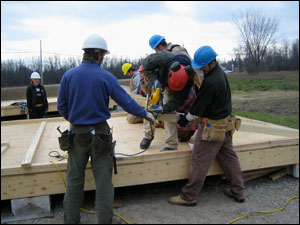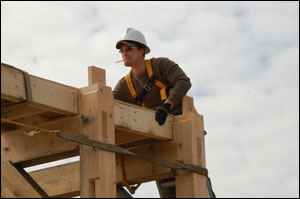FAQ

What exactly is the Carpentry & Joinery – Heritage program all about?
This is a two-year diploma program that combines new construction technology with traditional carpentry techniques. The first year of the program focuses on modern construction practices, including framing, roofing and finish carpentry. Focus in the second year is on traditional building methods, including timber framing, log construction and joinery. In addition, students study historical Canadian architecture, construction methods and preservation techniques that allow students to produce the high-quality work demanded by the field of heritage carpentry.
Is the program all “hands-on”?
No, not at all! Despite this common misconception for trades training, this program has a balance of theory and practical courses. Lectures, note-taking, math, communications skills, drafting, research and report writing comprise a significant part of the program. The “hands-on” activities are designed to provide students with an opportunity to put the “theory” into practice. Successful students spend at least as much time completing assignments for their theory-based courses as on their practical projects.

Is there a lot of homework?
Yes. To be successful, a typical student will need to do one hour of homework for every hour of theory class. So, on average, a student must be prepared to spend a minimum of 10-15 hours per week on homework. Quizzes, tests, term papers, group projects and final exams are part of the evaluation scheme for most courses.
Do I need to have previous trades experience?
No. The program is organized to challenge and meet the learning requirements for students with a wide range of backgrounds, from those with little or no experience in the trades to individuals with time on the job, but who lack the theoretical background needed to excel in the trade. No doubt, it helps to have some basic carpentry skills, but, more importantly, is a strong desire to work in the trades, a solid foundation in math and communications, and an interest in historic Canadian architecture. Construction carpentry is considered to be physically demanding.
Do I have to be in good shape to take this program?
Once you join the workforce, you will be on your feet all day, lifting and moving lumber around, climbing ladders, sweeping and shovelling. Plain and simple, construction can be hard work so it helps to be in shape. To fully participate in all aspects of the trade, you need to be committed to being in shape and conscious of your health.

I’m not sure if a career in the trades and taking this program is what I really want.
This is a challenging two-year diploma program geared for the student who is committed to a career in the intellectually and physically demanding construction carpentry industry. Working as a heritage Carpentry and Joinery carpenter requires strong math and communication skills, a sound understanding of building science, an ability to research products and materials, the technical expertise to layout, cut, and assemble components, and a passion for heritage buildings.
This program requires hard work, determination and commitment. Heritage Carpentry and Joinery is a challenging and rewarding career, and we believe there is no better way to start out than through taking this program. We would like to help you make the right choice. Should you require more information, please don’t hesitate to contact us
Once I’ve completed the program, are there other programs I can take or that I can enter into where I can receive advanced standing?
Yes. A pathway for Heritage Carpentry graduates has been pre-approved into the Bachelor of Applied Science (Building Conservation) (Honours) program. For more information, visit the FAQ on the program page. For more information on pathways, you can also visit our Pathways finder tool on our website.